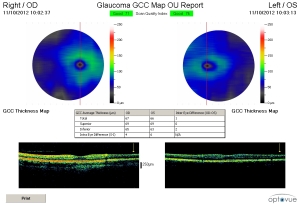Elevated eye pressures are the earliest known signs of glaucoma. The eye has a pressure of 15 mm-Hg on average. This test can be done in many ways, including the “puff” test, Goldman applanation, Tonopen, iCare rebound, and the new Ocular Response Analyzer. So with testing elevated pressure can be determined as the cause of the glaucoma. However we know this is NOT a simple disease.
The eye pressure test is not as sensitive or specific for glaucoma as we would like it to be. So patients have False Positive and False Negative Test results. The normal pressure patients will begin to overlap the glaucoma patients at any pressure. So the False positive patients get unneeded medical care and treatments. The worst are the False negatives, these patients are told that disease is not present, only it is slowly blinding the eye.
So other methods are being combined to correctly diagnosis Glaucoma. These include:
- A dilated eye, retinal exam using a bio-microscope and a 90 dioptor lens. (extended ophthalmoscopy)
- A 3D stereo photograph of the retina. (Fundus photography)
- A measurement of corneal thickness or corneal hysteresis.
- A Visual Field test to measure the vision function to 24 degrees in decibels of light perception.
- A Spectral Domain Ocular Coherence Tomography of the retina and of the macular. (SD-OCT)
- Tracking of the nerve fiber layer loss over time using the SD-OCT
- Tracking of the retinal ganglion cell loss over time using the SD-OCT
- Directly view the angle of the Iris attachment to the sclera at the trabecular membrane. Diagnostic of closed angle glaucoma is a narrow angle. (Gonioscopy)
- Ultrasound view of the hidden areas near the angle and lens to view causes of angle closure.(UBM)
- Blood Pressure, very high or very low aggravate glaucoma.
